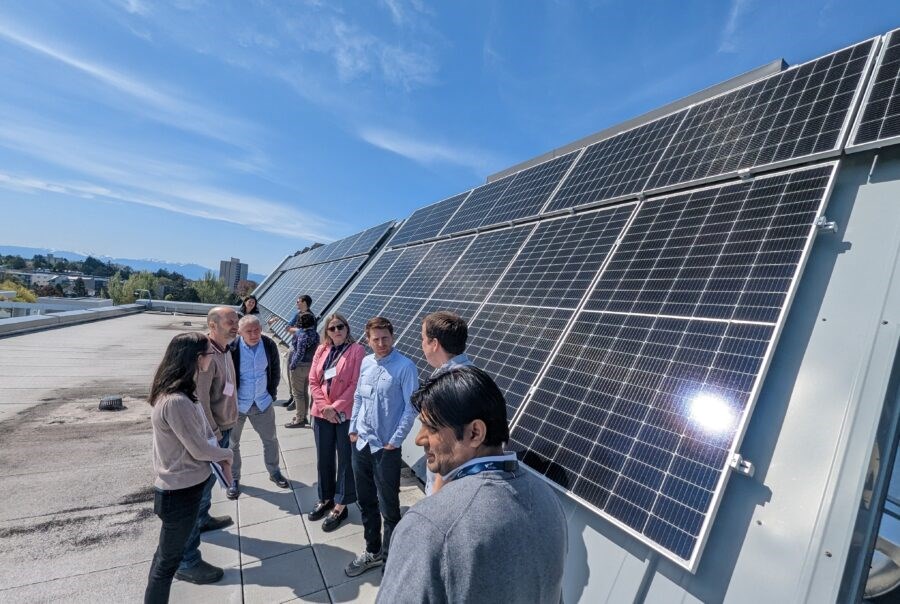A network of commercial buildings in Greater Victoria is on track to achieve ambitious emissions-reduction targets by 2030.
Greater Victoria is currently the only municipality in British Columbia that has signed up to participate in the 2030 Districts Network—a global initiative to build sustainable commercial building districts by reducing energy usage, water consumption and transportation-related emissions.
“The main concept is we bring together property managers in the region to work towards deep reductions in greenhouse gas emissions and energy use, focusing on commercial property managers,” says Cora Hallsworth, director of Greater Victoria 2030 District.
“Our goal is we want to create this hub of high-performing buildings, helping the buildings reduce their emissions and become resilient to climate change as well.”
Forty-four commercial buildings in Greater Victoria have joined the network since its launch in 2021, according to Hallsworth, and that number continues to grow. All participating properties have committed to reducing their emissions by 50 per cent from their 2007 emissions level by 2030.
“Most of them are definitely on track,” says Hallsworth.
“The buildings are using 35 per cent less energy as a whole and also 55 per cent less in emissions, and many buildings have already met the targets and are going to well exceed that,” she adds. “We have a beyond-2030 goal as well to strive towards net zero.”
Hallsworth says they used 2007 as a benchmark because it was when many international and national sustainability targets were set.
The commercial buildings participating in the Greater Victoria 2030 District are adopting a range of measures to reduce their emissions and increase their energy efficiency, such as installing advanced building controls, smart-building systems, geothermal systems, solar panels and LED lighting, according to Hallsworth.
Anthem Properties Group Ltd.’s Tillicum Centre in Victoria is one of the buildings participating in the initiative. The property is within 13 per cent of achieving its 2030 emissions-reduction goal due to recent improvements, according to the company.
“We are really happy with the results [given that] we still have six years left,” says Elyse Kituri, director of property management at Anthem and past chair of the Building Owners and Managers Association of British Columbia’s (BOMA BC) Victoria chapter.
Kituri says that the Greater Victoria 2030 District has provided participating property managers an opportunity to learn how to evaluate the current operations of existing buildings, and how to optimize performance and efficiency in a way that makes sense.
For many buildings, reaching the 2030 benchmark can be a momentous feat, considering that building owners often only have control over a building’s common areas, and don’t have access or control over tenant energy consumption, according to Kituri.
“Through the collaboration of the district, we’re now able to access aggregated site data in order to collect the full property energy consumption,” she says, adding that collaboration between owners and tenants is key to achieving the emissions-reduction goal.
Despite progress to date, Hallsworth says there are numerous challenges the network needs to overcome to meet its 2030 target and to also grow the number of buildings participating in the project. Many office buildings are still recovering from financial challenges following years of vacancies during the pandemic.
“They’re starting to bounce back from that, but it seems there’s been some ongoing aftereffects of that. There’s also a lot of changes in different acquisitions, mergers and changing ownership, so there’s always a bit of a start-over process with that,” says Hallsworth.
She says the “island effect” of Victoria also adds to challenges faced by property owners, as acquiring certain services to implement specific sustainability measures may be less readily available and more expensive. To counter than, the district looking into pooled purchasing opportunities.
Access to capital — and capital’s increasing cost — are also roadblocks, says Kituri. She says the district and BOMA BC are looking at ways to address capital challenges. These may include funding through the Canada Infrastructure Bank, which has options available for green infrastructure, building retrofits and decarbonization projects.
Hallsworth says the district’s focus in 2024 is to bring more smaller property managers on board. It is also working with the University of Victoria to develop an online resiliency tool slated to be available next year.
“[It’s] where commercial property can evaluate and prioritize actions for mitigating climate risks, how they can do retrofits to reduce emissions, and also make sure that they’re less vulnerable to the impacts of climate change,” she says.
This article was originally published in Office Space Magazine.






